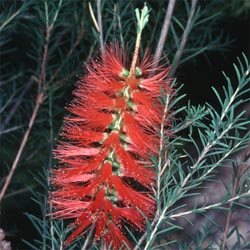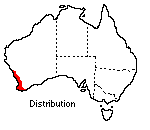Melaleuca lateritia
 |
 |
Robin Red-breast Bush
Melaleuca lateritia, commonly known as the Robin Red-breast Bush, is
one of many beautiful Melaleuca species native to the south-west province
of Western Australia. It is an erect shrub and although rarely exceeding 1.5
m high by 1 m in diameter in Canberra, often reaches over 2 m in damp situations
in the south-west. Its habit is usually open and without pruning it may become
untidy and woody at the base. With regular tip pruning, a more compact shrub
is obtained.
 Leaves
are light green, about 2 cm long, more or less linear and taper to a fine point.
The orange-red, bottlebrush flower spikes grow up to 9 cm long and 5 cm in diameter.
They are usually borne on the older wood on small lateral growths. Sometimes
flowers are seen close to the ground on very old bushes.
Leaves
are light green, about 2 cm long, more or less linear and taper to a fine point.
The orange-red, bottlebrush flower spikes grow up to 9 cm long and 5 cm in diameter.
They are usually borne on the older wood on small lateral growths. Sometimes
flowers are seen close to the ground on very old bushes.
The main flowering period is summer, but some blooms are seen through to autumn and early winter when frost often destroys developing buds. Frost, however, is not an extreme problem as the shrub's vigour is not affected.
Seed is set prolifically on most bushes and the woody capsules persist on the shrub for many years. These may be removed if they look untidy or to improve vigour if the shrub is sparse. By storing the older capsules in a paper bag in a warm place, seeds are quickly released and provide a ready means of propagation. The shrub is also propagated readily from cuttings, using half-hardened wood.
In cultivation, a reasonably well-drained soil and full sun are preferred but M. lateritia will survive and give good flowering in most situations. Ample moisture and regular application of a general fertilizer together with an effective mulch provide the ingredients for good cultivation. The flowers are often visited by honeyeaters, particularly the Eastern Spinebill and New Holland Honeyeaters in Canberra.
M. lateritia should be grown in a prominent position because of its long flowering period at a time when flowers are scarce in the native garden. It appears to be relatively free of pests and diseases.
Text by ANBG staff (1978)
Name meaning: Melaleuca lateritiaMelaleuca - from two Greek words, melas, black, and leukos, white, because the first Melaleuca described had white branches against a black trunk, possibly blackened by fire (another opinion contrasts the white bark with the very dark foliage of some species); lateritia - from the Latin meaning brick red, referring to the flowers. |
![An Australian Government Initiative [logo]](/images/austgovt_brown_90px.gif)

